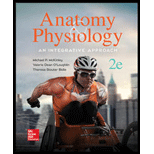
Introduction:
Nasal septum divides the nasal cavity into right and left halves and it creates the two nostrils. It divides the nose into two nostrils. The depressor septi nasi muscle depresses the nasal septum. The external fleshy end of the nasal septa is referred as the columella.
Answer to Problem 1DYKB
Correct answer:
Nasal septum is formed by two bones; vomer and perpendicular plate of the ethmoid bone. Therefore, option a. is correct.
Explanation of Solution
Reason for the correct statement:
Option a. is given as “perpendicular plate of the ethmoid bone and vomer”. Nasal septum contains hyaline cartilage and bone. The nasal septum is made up of five structures. These structures include vomer bone, perpendicular plate of ethmoid bone, septal nasal cartilage, crest of maxillary and palatine bone. Hence, the two bones that form the nasal septum are vomer and perpendicular plate of ethmoid bone.
Hence, option a. is correct.
Reasons for the incorrect statements:
Option b. is given as “perpendicular plate of the ethmoid bone only”. Nasal septum is also formed from vomer bone. Hence, option b. is incorrect.
Option c. is given as “nasal bones and perpendicular plate of the ethmoid bone”. There are no nasal bones in nasal septum. Hence, option c. is incorrect.
Option d. is given as “vomer and sphenoid bones”. Sphenoid bones do not form the nasal septum. Hence, option d. is incorrect.
Hence, options b., c., and d. are incorrect.
The nasal septum is made up of vomer bone, perpendicular plate of ethmoid bone, septal nasal cartilage, crest of maxillary and palatine bone.
Want to see more full solutions like this?
Chapter 8 Solutions
Anatomy & Physiology: An Integrative Approach
- In one paragraph show how atoms and they're structure are related to the structure of dna and proteins. Talk about what atoms are. what they're made of, why chemical bonding is important to DNA?arrow_forwardWhat are the structure and properties of atoms and chemical bonds (especially how they relate to DNA and proteins).arrow_forwardThe Sentinel Cell: Nature’s Answer to Cancer?arrow_forward
- Molecular Biology Question You are working to characterize a novel protein in mice. Analysis shows that high levels of the primary transcript that codes for this protein are found in tissue from the brain, muscle, liver, and pancreas. However, an antibody that recognizes the C-terminal portion of the protein indicates that the protein is present in brain, muscle, and liver, but not in the pancreas. What is the most likely explanation for this result?arrow_forwardMolecular Biology Explain/discuss how “slow stop” and “quick/fast stop” mutants wereused to identify different protein involved in DNA replication in E. coli.arrow_forwardMolecular Biology Question A gene that codes for a protein was removed from a eukaryotic cell and inserted into a prokaryotic cell. Although the gene was successfully transcribed and translated, it produced a different protein than it produced in the eukaryotic cell. What is the most likely explanation?arrow_forward
- Molecular Biology LIST three characteristics of origins of replicationarrow_forwardMolecular Biology Question Please help. Thank you For E coli DNA polymerase III, give the structure and function of the b-clamp sub-complex. Describe how the structure of this sub-complex is important for it’s function.arrow_forwardMolecular Biology LIST three characteristics of DNA Polymerasesarrow_forward
 Medical Terminology for Health Professions, Spira...Health & NutritionISBN:9781305634350Author:Ann Ehrlich, Carol L. Schroeder, Laura Ehrlich, Katrina A. SchroederPublisher:Cengage LearningBasic Clinical Lab Competencies for Respiratory C...NursingISBN:9781285244662Author:WhitePublisher:Cengage
Medical Terminology for Health Professions, Spira...Health & NutritionISBN:9781305634350Author:Ann Ehrlich, Carol L. Schroeder, Laura Ehrlich, Katrina A. SchroederPublisher:Cengage LearningBasic Clinical Lab Competencies for Respiratory C...NursingISBN:9781285244662Author:WhitePublisher:Cengage Fundamentals of Sectional Anatomy: An Imaging App...BiologyISBN:9781133960867Author:Denise L. LazoPublisher:Cengage Learning
Fundamentals of Sectional Anatomy: An Imaging App...BiologyISBN:9781133960867Author:Denise L. LazoPublisher:Cengage Learning Cardiopulmonary Anatomy & PhysiologyBiologyISBN:9781337794909Author:Des Jardins, Terry.Publisher:Cengage Learning,
Cardiopulmonary Anatomy & PhysiologyBiologyISBN:9781337794909Author:Des Jardins, Terry.Publisher:Cengage Learning,





